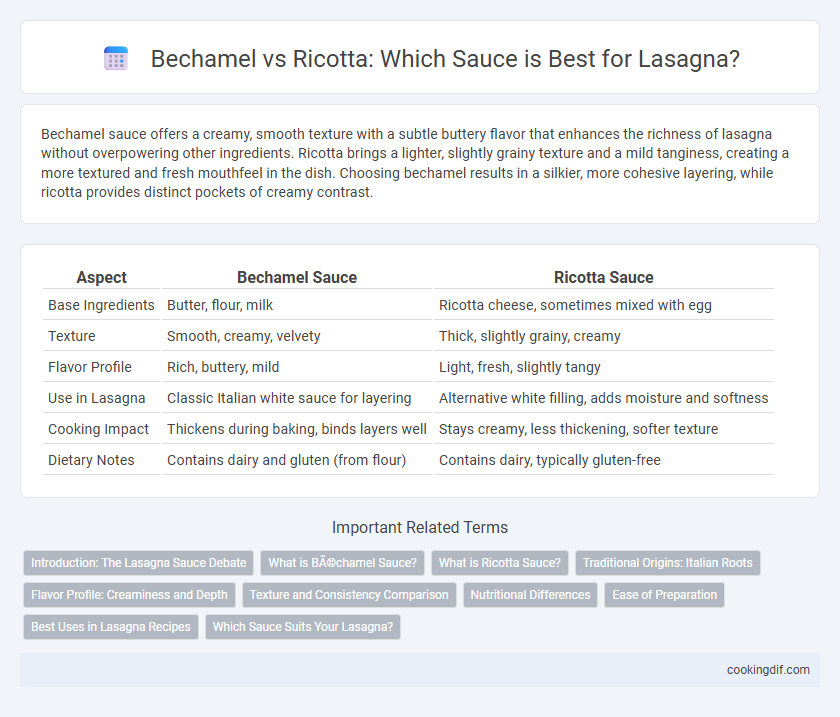Bechamel sauce offers a creamy, smooth texture with a subtle buttery flavor that enhances the richness of lasagna without overpowering other ingredients. Ricotta brings a lighter, slightly grainy texture and a mild tanginess, creating a more textured and fresh mouthfeel in the dish. Choosing bechamel results in a silkier, more cohesive layering, while ricotta provides distinct pockets of creamy contrast.
Table of Comparison
| Aspect | Bechamel Sauce | Ricotta Sauce |
|---|---|---|
| Base Ingredients | Butter, flour, milk | Ricotta cheese, sometimes mixed with egg |
| Texture | Smooth, creamy, velvety | Thick, slightly grainy, creamy |
| Flavor Profile | Rich, buttery, mild | Light, fresh, slightly tangy |
| Use in Lasagna | Classic Italian white sauce for layering | Alternative white filling, adds moisture and softness |
| Cooking Impact | Thickens during baking, binds layers well | Stays creamy, less thickening, softer texture |
| Dietary Notes | Contains dairy and gluten (from flour) | Contains dairy, typically gluten-free |
Introduction: The Lasagna Sauce Debate
Bechamel sauce offers a creamy, velvety texture with a subtle flavor that enhances the layers of traditional lasagna, while ricotta provides a rich, slightly tangy taste that adds a distinctive crumbly consistency. Italian chefs often debate which sauce best complements classic lasagna, balancing moisture and richness to achieve the ideal mouthfeel. Understanding the unique properties of bechamel versus ricotta is essential for crafting authentic and flavorful lasagna.
What is Béchamel Sauce?
Bechamel sauce, a classic French white sauce made from butter, flour, and milk, serves as a creamy and velvety base in traditional lasagna recipes, providing a smooth texture that enhances the layers of pasta and meat. Unlike ricotta, which is a cheese with a grainy texture and slightly sweet taste, bechamel adds a rich, buttery flavor and a thicker consistency that binds ingredients cohesively. Its subtle taste allows other flavors in the lasagna, such as tomato sauce and Parmesan, to shine while delivering moisture and creaminess.
What is Ricotta Sauce?
Ricotta sauce is a creamy, mild Italian cheese-based sauce made primarily from ricotta cheese, often combined with eggs, Parmesan, and herbs to create a rich, textured layer in lasagna. Unlike bechamel, which is a smooth white sauce made from butter, flour, and milk, ricotta sauce offers a thicker consistency and a subtly sweet, tangy flavor. Using ricotta sauce in lasagna enhances the dish with a custard-like richness and a hearty, satisfying mouthfeel.
Traditional Origins: Italian Roots
Traditional Italian lasagna relies on Bechamel sauce, a creamy mixture of butter, flour, and milk, which originates from northern Italy, particularly Emilia-Romagna. Ricotta, commonly used in southern Italian lasagnas, especially in regions like Naples and Sicily, provides a thicker, grainier texture that contrasts with Bechamel's smoothness. These regional differences highlight Italy's diverse culinary heritage in layering sauces for authentic lasagna recipes.
Flavor Profile: Creaminess and Depth
Bechamel sauce offers a rich, velvety creaminess with a subtle buttery flavor that enhances lasagna's depth, creating a smooth, cohesive texture throughout the layers. Ricotta provides a lighter, slightly grainy texture with a mild, tangy taste, adding brightness and a fresh contrast to the richness of tomato and meat sauces. Choosing bechamel enriches the lasagna's overall creaminess, while ricotta contributes a distinct, airy creaminess with nuanced acidity.
Texture and Consistency Comparison
Bechamel sauce offers a smooth, creamy texture with a velvety consistency that binds lasagna layers seamlessly, creating a rich mouthfeel. Ricotta, on the other hand, provides a slightly grainy texture with a thicker, more substantial consistency that adds a rustic heartiness to the dish. Choosing between Bechamel and Ricotta influences the lasagna's overall creaminess and structural integrity significantly.
Nutritional Differences
Bechamel sauce, made from butter, flour, and milk, offers a creamy texture with moderate protein and calcium content but higher saturated fat and calories. Ricotta, derived from whey, provides more protein and lower fat, making it a nutritious option rich in calcium and essential amino acids. Choosing between bechamel and ricotta impacts the lasagna's nutritional profile, influencing calorie density and macronutrient balance.
Ease of Preparation
Bechamel sauce requires careful whisking of butter, flour, and milk to achieve a smooth, creamy texture without lumps, which can be time-consuming for beginners. Ricotta offers a simpler alternative with its ready-to-use creamy consistency, eliminating the need for cooking or constant stirring. Choosing ricotta enhances ease of preparation, especially for quick lasagna recipes or when minimizing kitchen time.
Best Uses in Lasagna Recipes
Bechamel sauce provides a creamy, smooth texture with a subtle buttery flavor that enhances traditional Italian lasagna, making it ideal for recipes aiming for richness and cohesiveness. Ricotta offers a thicker, slightly grainy consistency with a mild, tangy taste, best suited for layered lasagnas that emphasize a hearty, rustic feel and lighter creaminess. Selecting Bechamel is optimal for classic bechamel-cream based lasagnas, while ricotta shines in vegetable or meat lasagnas where texture variety and flavor depth are desired.
Which Sauce Suits Your Lasagna?
Bechamel sauce provides a creamy, smooth texture with a mild, buttery flavor that complements the rich meat and tomato layers in traditional lasagna. Ricotta offers a thicker, grainier consistency with a slightly tangy taste, ideal for a lighter, fresher lasagna often paired with vegetables or spinach. Choosing between bechamel and ricotta depends on whether you prefer a rich, velvety sauce or a denser, more substantial layer in your lasagna.
Béchamel vs Ricotta for sauce Infographic

 cookingdif.com
cookingdif.com